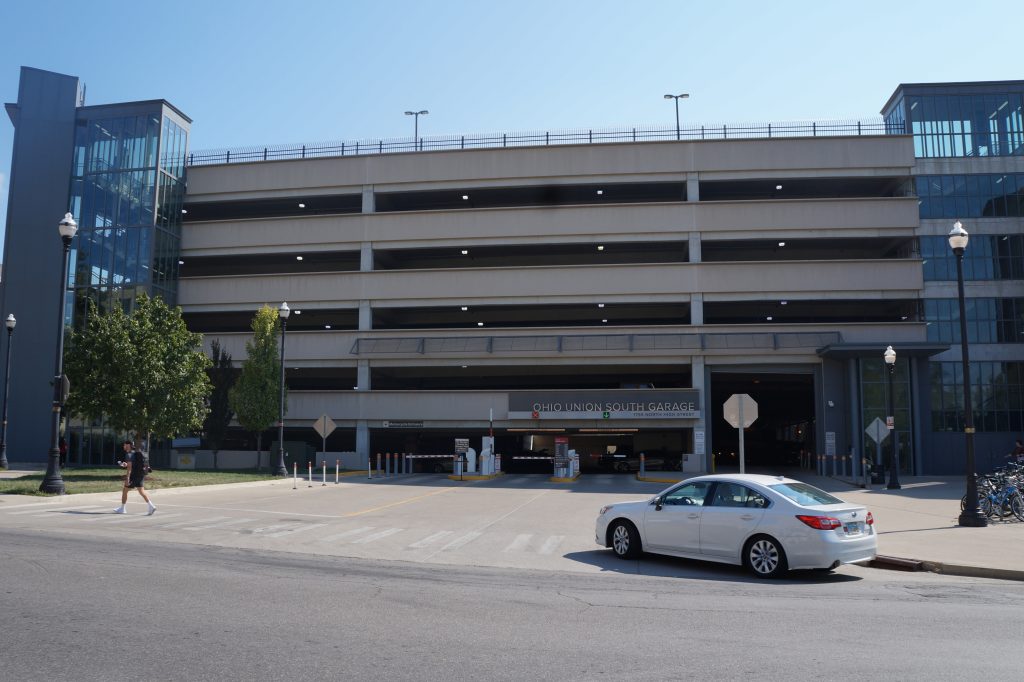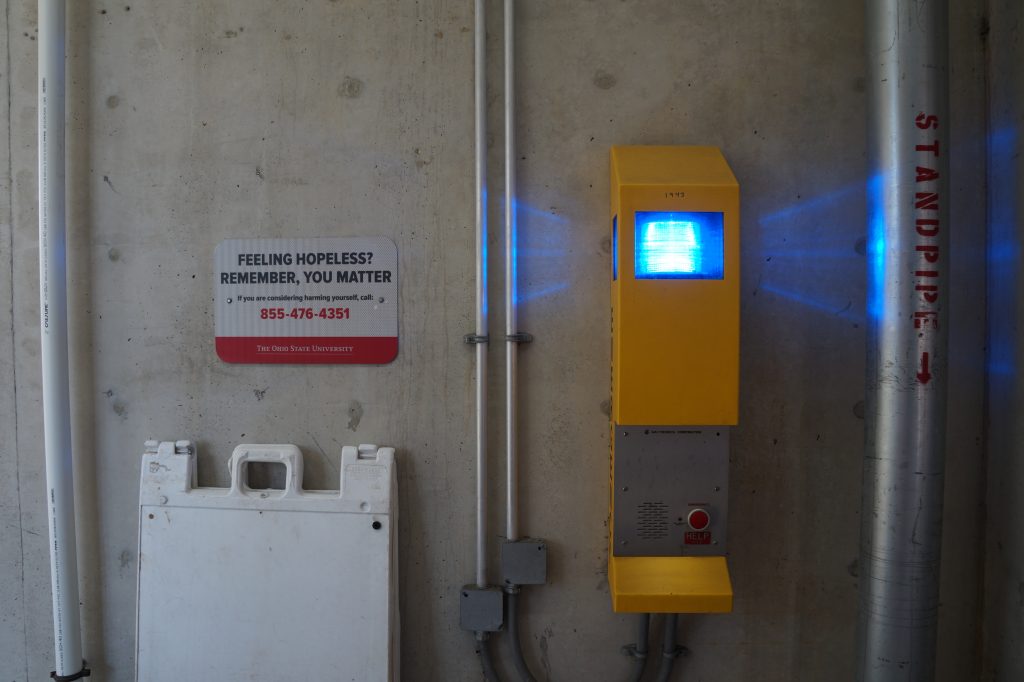by Amber Fan
Campus parking garages accumulate high level of traffic every day. OSU’s parking garages are one of the most used public spaces occupied by people, especially students, faculty and staffs. Considering past tragedies where students have committed suicide from the Ohio Union South Garage, I see an urgent need in improving the garage atmosphere here on campus in order to create a more positive environment for students’ wellbeing.
Student mental health problem has long been a major concern in universities. The amount of pressure from schoolwork, competition, job-search could all serve as driving factors for mental health problems, such as anxiety, depression and so on. An article from The New York Times, focusing on students’ mental health problems in Pennsylvania State University, has put forth social psychologist Leon Festinger’s comparison theory “…which posits that we try to determine our worth based on how we stack up against others” (Scelfo). This article also suggests that since nowadays students seem to be “…ultra-focused on success but don’t know how to fail…”, thus tragedy occurs: six Penn State students committed suicide in a 13-month stretch in 2015; Tulane University and Appalachian State University have all lost students due to suicide during the same school year. “Cornell faced six suicides in the 2009-10 academic year. In 2003-4, five New York University students leapt to their deaths” (Scelfo). Sadly, these data have proven to us that student suicide isn’t only a concern to Ohio State University, as we recall the three incidents that happened in Lane Ave Garage as well as Union South Garage, hence there is an urge that we start taking actions to help here and now.


OSU has made moves to better prevent student suicide by enhancing the school’s counseling service as well as installing protective fences on the top level of Union South Garage and shutting down the top floor of other on-campus garages. However, as effective as these measures might seem for now, they also pose considerable amount of controversy. In my survey surrounding OSU parking garage environments, I asked participants to quickly stress their opinions on installing fences around the top Union South Garage. While there is a common recognition in that fences can help prevent further suicide attempts, there is also concerns of “feeling caged in”, “creating a negative environment when entering the parking garage”, “fences seem like a reminder that people jump off the top”, “not solving the real problem”, etc. To make the situation even more complex, during my filed studies to Union South Garage, I found that only the top floor has fences installed, despite the garage being a 6-floor building. The openness of other floors could still invite suicide and cause injury, not to mention all the other on-campus garages which do not have fences whatsoever. For the abovementioned reasons, I think a more creative and systematic solution must be found to better address the issue.

Aside from student mental well-being, I’ve also noticed a collective concern in parking garage safety at night. When surveyed, only 7 people out of 47 participants reported a 5 on a 1 to 5 scale (1 being unsafe, 5 being safe). On the other hand, 19 people have reported a 2 on the scale and 4 people have reported 1, hence a strong tendency towards feeling unsafe when using the parking garage at night. According to the article “Performance of Campus Parking Garages in Preventing Crime”, “The OSU Security Services Department was concerned that garages were one of the crime hot spots because of their inactivity relative to other campus buildings” (Chun-Hao Tseng). Such concern is proven to be no surprise based on data collected from “Daily Crime Log” under OSU Public Safety Department. The log keeps track of a total of 340 crimes that happened on campus during the past two months (7/05/19~9/03/19). Out of the 340 crimes, 21 incidents had taken place in campus garages (excluding parking lots), where 9 out of 16 parking garages were involved. Although some might argue that it’d be overstating to refer to the campus garage as “crime hot spot”, it is important to keep in mind that “The notion of safety varies from one person to another; it is expressed subjectively…” (Chun-Hao Tseng). Garage users’ sense of safety plays a major role when examining an environment. The authors of “Safety Evaluation for Campus Parking Garage Performance using Fuzzy Logic” suggest that “Security is often referred to as the physical protection of personal property against the risk of being damaged or lost, while safety is associated with human well-being regarding the surrounding environment” (Chun-Hao Tseng). Based on the definition and differentiation between security and safety, I believe that there is an opportunity to increase both within on-campus garages, especially during night times.

I intend to use lighting as means to improve the parking garage environments since illumination could have strong effects on people’s behavior and mood. During my research, I found an article that discusses the installation of blue lights at a Japanese train station to help prevent suicide. Although researchers have stated “The scientific evidence that blue light really can reduce the rate of suicide is mixed, and the true effect is probably smaller than often reported” (Baraniuk), I see potentials in using lighting to help with the problem. Further, experts in Crime Prevention Through Environmental Design agree that “…illumination is the most significant factor affecting both user perception of safety and actual incidence of crime in parking garages” (Chun-Hao Tseng), which further proves lighting to be the appropriate tool to utilize. Nowadays with the development of major lighting manufacturers such as Philips Lighting and General Electronics, etc. more and more innovative lighting technologies have been commercialized. One example could be Philips Hue, where an app is integrated along with the lighting fixture, allowing users to customize the color of the light to best fit their mood. Another example would be a smart lighting system offered by GE, in which case the embedded sensors in lighting fixtures not only monitor their surroundings, but also collect and analyze data. By doing so, potential threats and security concerns could be predicted analytically, thus preventive actions can be taken beforehand. Emergence of smart lighting has brought upon various possibilities. I think there is plenty of opportunities that lighting design could come into play in order to foster a positive parking garage environment as well as ensure students’ wellbeing and safety.
While both student mental health problem and safety at parking garages are worthy of investigation, it is important to keep in mind that there is no such thing as the “perfect solution”. According to Fonda Bryant, “…a mental health activist in Charlotte, N.C., who designed suicide-prevention signs…”, “…she knows some people might criticize her signs as addressing only a problem’s symptoms and not its root causes, but she said prevention efforts have to start somewhere” (Iati). I agree strongly with Bryant here. I think when dealing with a complex problem, sometimes identifying and addressing the symptoms is exactly what’s needed. Similar to Bryant’s approach, lighting design could only serve as one method to help with the problem, improving the on-campus parking garage environment, instead of solving student suicide or putting an end to crime.
All in all, I recognize an urgent need in addressing the problems that exist within the on-campus parking garages, including student suicide and safety at night. Through lighting design, a creative and noninvasive measure, I wish to improve the parking garage environments, creating a healthier and more positive atmosphere that ensures students’ wellbeing and safety.
Work Cited
Baraniuk, Chris. “Future – Can Blue Lights Prevent Suicide at Train Stations?” BBC, BBC, 23 Jan. 2019, www.bbc.com/future/story/20190122-can-blue-lights-prevent-suicide-at-train-stations.
“Current by GE: Intelligent Energy Management.” Current by GE: Intelligent Energy Management, www.currentbyge.com/.
Chun-Hao Tseng, et al. “Safety Evaluation for Campus Parking Garage Performance Using Fuzzy Logic.” Journal of Performance of Constructed Facilities, vol. 18, no. 3, Aug. 2004, pp. 127–135. EBSCOhost, doi:10.1061/(ASCE)0887-3828(2004)18:3(127).
Chun-Hao Tseng, Neeraj, et al. “Performance of Campus Parking Garages in Preventing Crime.” Journal of Performance of Constructed Facilities, vol. 18, no. 1, Feb. 2004, pp. 21–28. EBSCOhost, doi:10.1061/(ASCE)0887-3828(2004)18:1(21).
“LED Integrated White Beyond Ceiling Light.” Hue, www2.meethue.com/en-us/p/hue-white-and-color-ambiance-beyond-ceiling-light/712013148.
Iati, Marisa. “A Parking Garage Had 6 Suicides in 4 Years. Signs on the Walls Are Trying to Prevent More.” The Washington Post, WP Company, 26 Aug. 2019, www.washingtonpost.com/lifestyle/2019/08/26/parking-garage-had-suicides-years-signs-walls-are-trying-prevent-more/?noredirect=on.
Scelfo, Julie. “Suicide on Campus and the Pressure of Perfection.” The New York Times, The New York Times, 27 July 2015, www.nytimes.com/2015/08/02/education/edlife/stress-social-media-and-suicide-on-campus.html?searchResultPosition=7.




